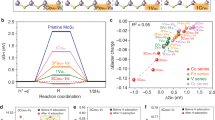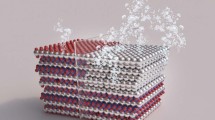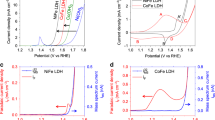Abstract
Low-cost, layered transition-metal dichalcogenides (MX2) based on molybdenum and tungsten have attracted substantial interest as alternative catalysts for the hydrogen evolution reaction (HER). These materials have high intrinsic per-site HER activity; however, a significant challenge is the limited density of active sites, which are concentrated at the layer edges. Here we unravel electronic factors underlying catalytic activity on MX2 surfaces, and leverage the understanding to report group-5 MX2 (H-TaS2 and H-NbS2) electrocatalysts whose performance instead mainly derives from highly active basal-plane sites, as suggested by our first-principles calculations and performance comparisons with edge-active counterparts. Beyond high catalytic activity, they are found to exhibit an unusual ability to optimize their morphology for enhanced charge transfer and accessibility of active sites as the HER proceeds, offering a practical advantage for scalable processing. The catalysts reach 10 mA cm−2 current density at an overpotential of ∼50–60 mV with a loading of 10–55 μg cm−2, surpassing other reported MX2 candidates without any performance-enhancing additives.
This is a preview of subscription content, access via your institution
Access options
Access Nature and 54 other Nature Portfolio journals
Get Nature+, our best-value online-access subscription
$29.99 / 30 days
cancel any time
Subscribe to this journal
Receive 12 digital issues and online access to articles
$119.00 per year
only $9.92 per issue
Buy this article
- Purchase on Springer Link
- Instant access to full article PDF
Prices may be subject to local taxes which are calculated during checkout




Similar content being viewed by others
References
Turner, J. A. Sustainable hydrogen production. Science 305, 972–974 (2004).
Greeley, J., Jaramillo, T. F., Bonde, J., Chorkendorff, I. & Norskov, J. K. Computational high-throughput screening of electrocatalytic materials for hydrogen evolution. Nat. Mater. 5, 909–913 (2006).
Faber, M. S. & Jin, S. Earth-abundant inorganic electrocatalysts and their nanostructures for energy conversion applications. Energy Environ. Sci. 7, 3519–3542 (2014).
McCrory, C. C. L. et al. Benchmarking hydrogen evolving reaction and oxygen evolving reaction electrocatalysts for solar water splitting devices. J. Am. Chem. Soc. 137, 4347–4357 (2015).
Tavakkoli, M. et al. Single-shell carbon-encapsulated iron nanoparticles: synthesis and high electrocatalytic activity for hydrogen evolution reaction. Angew. Chem. Int. Edn 54, 4535–4538 (2015).
Chhowalla, M. et al. The chemistry of two-dimensional layered transition metal dichalcogenide nanosheets. Nat. Chem. 5, 263–275 (2013).
Karunadasa, H. I. et al. A molecular MoS2 edge site mimic for catalytic hydrogen generation. Science 335, 698–702 (2012).
Jaramillo, T. F. et al. Identification of active edge sites for electrochemical H2 evolution from MoS2 nanocatalysts. Science 317, 100–102 (2007).
Kibsgaard, J., Chen, Z., Reinecke, B. N. & Jaramillo, T. F. Engineering the surface structure of MoS2 to preferentially expose active edge sites for electrocatalysis. Nat. Mater. 11, 963–969 (2012).
Hinnemann, B. et al. Biomimetic hydrogen evolution: MoS2 nanoparticles as catalyst for hydrogen evolution. J. Am. Chem. Soc. 127, 5308–5309 (2005).
Benck, J. D., Hellstern, T. R., Kibsgaard, J., Chakthranont, P. & Jaramillo, T. F. Catalyzing the hydrogen evolution reaction (HER) with molybdenum sulfide nanomaterials. ACS Catal. 4, 3957–3971 (2014).
Lu, Q., Yu, Y., Ma, Q., Chen, B. & Zhang, H. 2D transition-metal-dichalcogenide-nanosheet-based composites for photocatalytic and electrocatalytic hydrogen evolution reactions. Adv. Mater. 28, 1917–1933 (2016).
Zhang, X., Lai, Z., Tan, C. & Zhang, H. Solution-processed two-dimensional MoS2 nanosheets: preparation, hybridization, and applications. Angew. Chem. Int. Edn 55, 8816–8838 (2016).
Chen, J. et al. One-pot synthesis of CdS nanocrystals hybridized with single-layer transition-metal dichalcogenide nanosheets for efficient photocatalytic hydrogen evolution. Angew. Chem. Int. Edn 54, 1210–1214 (2015).
Miao, J. et al. Hierarchical Ni–Mo–S nanosheets on carbon fiber cloth: a flexible electrode for efficient hydrogen generation in neutral electrolyte. Sci. Adv. 1, e1500259 (2015).
Schmickler, W. & Santos, E. Interfacial Electrochemistry 2nd edn (Springer, 2010).
Santos, E., Quaino, P. & Schmickler, W. Theory of electrocatalysis: hydrogen evolution and more. Phys. Chem. Chem. Phys. 14, 11224–11233 (2012).
Trasatti, S. Work function, electronegativity, and electrochemical behaviour of metals: III. Electrolytic hydrogen evolution in acid solutions. J. Electroanal. Chem. Interfacial Electrochem. 39, 163–184 (1972).
Calle-Vallejo, F., Koper, M. T. M. & Bandarenka, A. S. Tailoring the catalytic activity of electrodes with monolayer amounts of foreign metals. Chem. Soc. Rev. 42, 5210–5230 (2013).
Nørskov, J. K. et al. Trends in the exchange current for hydrogen evolution. J. Electrochem. Soc. 152, J23–J26 (2005).
Liu, Y., Wang, Y. M., Yakobson, B. I. & Wood, B. C. Assessing carbon-based anodes for lithium-ion batteries: a universal description of charge-transfer binding. Phys. Rev. Lett. 113, 028304 (2014).
Arikado, T., Iwakura, C. & Tamura, H. Some oxide catalysts for the anodic evolution of chlorine: reaction mechanism and catalytic activity. Electrochim. Acta 23, 9–15 (1978).
Arikado, T., Iwakura, C. & Tamura, H. A consideration of the electrochemical mechanism in the chlorine evolution reaction. Electrochim. Acta 23, 799–801 (1978).
Suntivich, J. et al. Design principles for oxygen-reduction activity on perovskite oxide catalysts for fuel cells and metal–air batteries. Nat. Chem. 3, 546–550 (2011).
Pan, H. Metal dichalcogenides monolayers: novel catalysts for electrochemical hydrogen production. Sci. Rep. 4, 5348 (2014).
Tsai, C., Chan, K., Nørskov, J. K. & Abild-Pedersen, F. Theoretical insights into the hydrogen evolution activity of layered transition metal dichalcogenides. Surf. Sci. 640, 133–140 (2015).
Yuan, J. et al. Facile synthesis of single crystal vanadium disulfide nanosheets by chemical vapor deposition for efficient hydrogen evolution reaction. Adv. Mater. 27, 5605–5609 (2015).
Voiry, D. et al. Enhanced catalytic activity in strained chemically exfoliated WS2 nanosheets for hydrogen evolution. Nat. Mater. 12, 850–855 (2013).
Lukowski, M. A. et al. Enhanced hydrogen evolution catalysis from chemically exfoliated metallic MoS2 nanosheets. J. Am. Chem. Soc. 135, 10274–10277 (2013).
Voiry, D. et al. Conducting MoS2 nanosheets as catalysts for hydrogen evolution reaction. Nano Lett. 13, 6222–6227 (2013).
Zeng, Z., Tan, C., Huang, X., Bao, S. & Zhang, H. Growth of noble metal nanoparticles on single-layer TiS2 and TaS2 nanosheets for hydrogen evolution reaction. Energy Environ. Sci. 7, 797–803 (2014).
Gupta, U., Rao, B. G., Maitra, U., Prasad, B. E. & Rao, C. N. R. Visible-light-induced generation of H2 by nanocomposites of few-layer TiS2 and TaS2 with CdS nanoparticles. Chem. Asian J. 9, 1311–1315 (2014).
Fletcher, S. Tafel slopes from first principles. J. Solid State Electrochem. 13, 537–549 (2009).
Zeradjanin, A. R., Ventosa, E., Bondarenko, A. S. & Schuhmann, W. Evaluation of the catalytic performance of gas-evolving electrodes using local electrochemical noise measurements. ChemSusChem 5, 1905–1911 (2012).
Gao, L. et al. Repeated growth and bubbling transfer of graphene with millimetre-size single-crystal grains using platinum. Nat. Commun. 3, 699 (2012).
Wang, Y. et al. Electrochemical delamination of CVD-grown graphene film: toward the recyclable use of copper catalyst. ACS Nano 5, 9927–9933 (2011).
Murphy, D. W. et al. Properties of HxTaS2: correlation between the superconducting Tc and an electronic instability in layer compounds. J. Chem. Phys. 62, 967–972 (1975).
Murphy, D. W. & Hull, G. W. Monodispersed tantalum disulfide and adsorption complexes with cations. J. Chem. Phys. 62, 973–978 (1975).
Blöchl, P. E. Projector augmented-wave method. Phys. Rev. B 50, 17953–17979 (1994).
Kresse, G. & Joubert, D. From ultrasoft pseudopotentials to the projector augmented-wave method. Phys. Rev. B 59, 1758–1775 (1999).
Perdew, J. P., Burke, K. & Ernzerhof, M. Generalized gradient approximation made simple. Phys. Rev. Lett. 77, 3865–3868 (1996).
Kresse, G. & Furthmüller, J. Efficient iterative schemes for ab initio total-energy calculations using a plane-wave basis set. Phys. Rev. B 54, 11169–11186 (1996).
Kresse, G. & Hafner, J. Ab initio molecular dynamics for liquid metals. Phys. Rev. B 47, 558–561 (1993).
Mathew, K., Sundararaman, R., Letchworth-Weaver, K., Arias, T. A. & Hennig, R. G. Implicit solvation model for density-functional study of nanocrystal surfaces and reaction pathways. J. Chem. Phys. 140, 084106 (2014).
Tsai, C., Abild-Pedersen, F. & Nørskov, J. K. Tuning the MoS2 edge-site activity for hydrogen evolution via support interactions. Nano Lett. 14, 1381–1387 (2014).
Kappera, R. et al. Phase-engineered low-resistance contacts for ultrathin MoS2 transistors. Nat. Mater. 13, 1128–1134 (2014).
McMullan, W. G. & Irwin, J. C. Raman scattering from 2H and 3R–NbS2 . Solid State Commun. 45, 557–560 (1983).
Carmalt, C. J., Manning, T. D., Parkin, I. P., Peters, E. S. & Hector, A. L. Formation of a new (1T) trigonal NbS2 polytype via atmospheric pressure chemical vapour deposition. J. Mater. Chem. 14, 290–291 (2004).
Acknowledgements
We thank W. Zhou (ORNL), W. I. Choi (LLNL), A. Mohite and G. Gupta (LANL) for valuable discussions. B.C.W. and Y.L. acknowledge funding from LLNL LDRD Grant 12-ERD-053, with computing support from the LLNL Institutional Computing Grand Challenge Program. T.O. and B.C.W. acknowledge additional support from the US Department of Energy (DOE) Fuel Cell Technologies Office. Y.M.W. acknowledges the UCOP funding support on mesoscopic 2D materials. A portion of this work was performed under the auspices of the US DOE by LLNL under Contract DE-AC52-07NA27344. K.P.H. acknowledges funding from PIRE-2 Grant OISE-0968405. J.W. and K.K. acknowledge funding from MURI 2D Grant W911NF-11-1-0362. Y.Y., J.Z. and J.L. acknowledge support from the Welch Foundation grant C-1716. Y.L. and B.I.Y. acknowledge support from the Office of Naval Research Grant N00014-15-1-2372 and the Army Research Office Grant W911NF-16-1-0255. This work used computing resources sponsored by the DOE Office of EERE at NREL, and the NSF XSEDE Grant ACI-1053575.
Author information
Authors and Affiliations
Contributions
Y.L. conceived the idea and performed the theory calculations with guidance from T.O., B.C.W. and B.I.Y. K.P.H. synthesized the samples. J.W. performed the electrochemical testing. J.W. and K.P.H. performed a majority of the materials characterization, under the guidance of R.V., J.L. and P.M.A. Other authors provided additional sample characterization.
Corresponding authors
Ethics declarations
Competing interests
The authors declare no competing financial interests.
Supplementary information
Supplementary Information
Supplementary Discussion, Supplementary Figures 1–18, Supplementary Table 1 and Supplementary References. (PDF 2542 kb)
Rights and permissions
About this article
Cite this article
Liu, Y., Wu, J., Hackenberg, K. et al. Self-optimizing, highly surface-active layered metal dichalcogenide catalysts for hydrogen evolution. Nat Energy 2, 17127 (2017). https://doi.org/10.1038/nenergy.2017.127
Received:
Accepted:
Published:
DOI: https://doi.org/10.1038/nenergy.2017.127
This article is cited by
-
From VIB- to VB-Group Transition Metal Disulfides: Structure Engineering Modulation for Superior Electromagnetic Wave Absorption
Nano-Micro Letters (2024)
-
Recent advances of two-dimensional metal-organic frameworks in alkaline electrolysis water for hydrogen production
Science China Chemistry (2023)
-
Application of in situ/operando characterization techniques in heterostructure catalysts toward water electrolysis
Nano Research (2023)
-
Regulating the Electrical and Mechanical Properties of TaS2 Films via van der Waals and Electrostatic Interaction for High Performance Electromagnetic Interference Shielding
Nano-Micro Letters (2023)
-
Tunable hydrogen evolution activity of black antimony–phosphorus monolayers via strain engineering: a first-principles calculation
Applied Physics A (2023)



